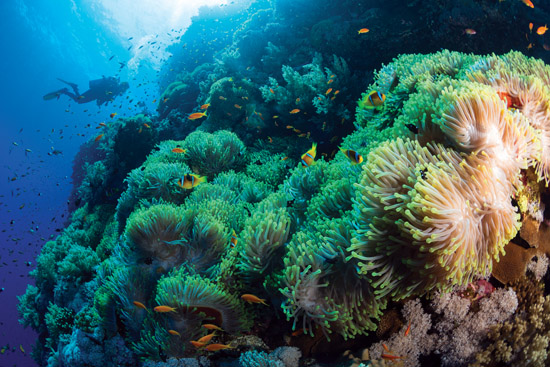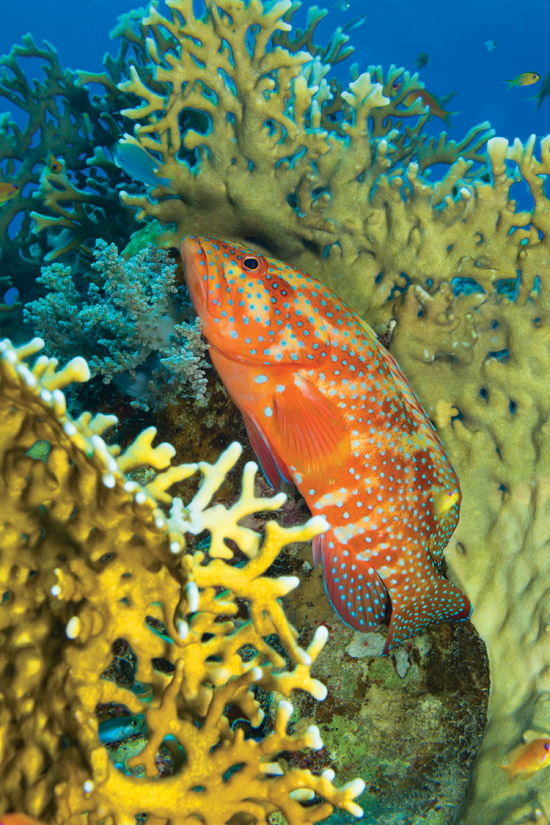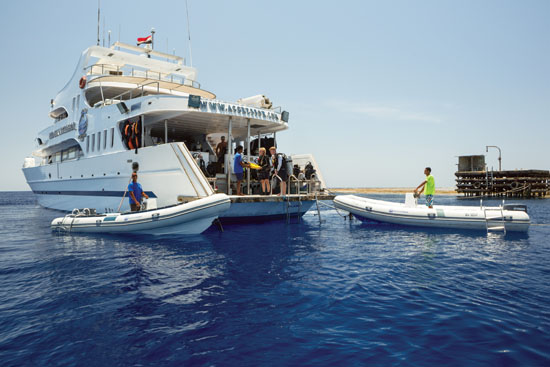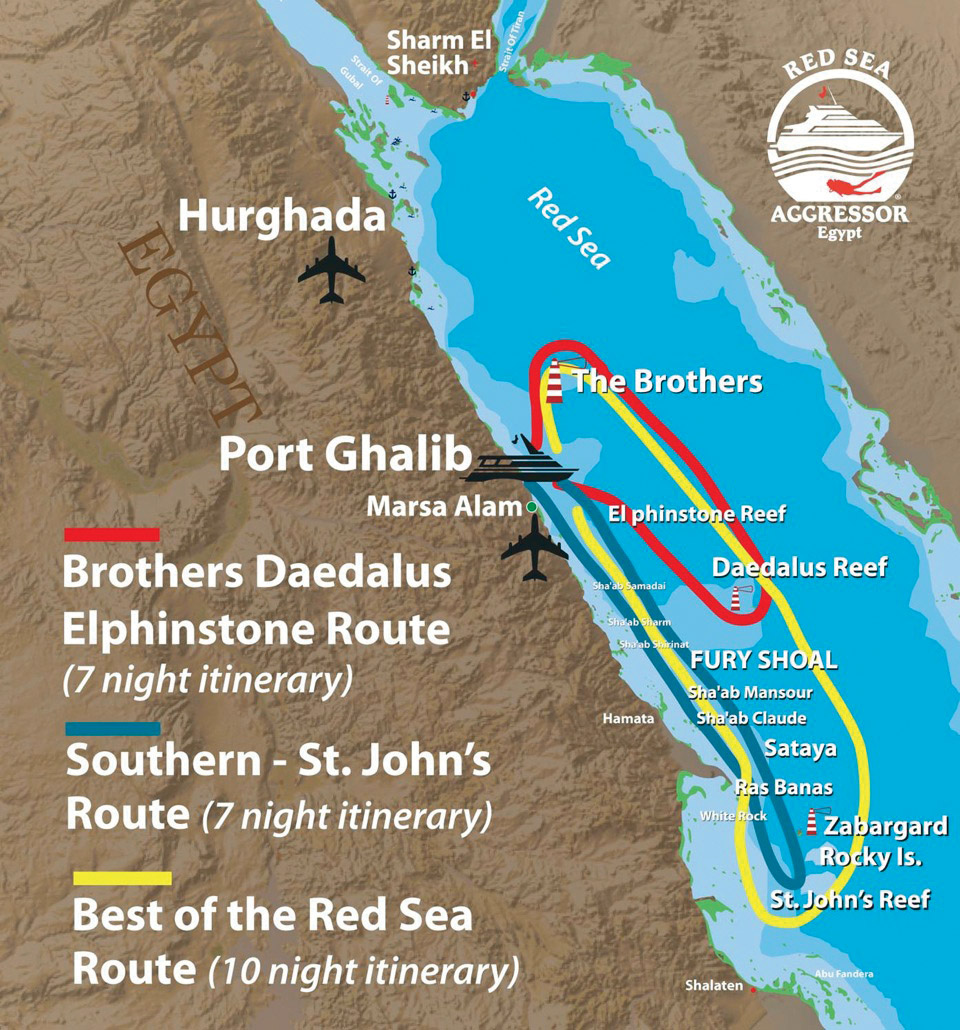Red Sea Rush – Exploring the Egyptian coast with the Aggressor Fleet
The brand new Red Sea Aggressor cruises down the southern Egyptian coast to dive sites remote and iconic, and they do it in style
Text by Michele Westmorland

When I told friends and family here in the United States I was headed to Egypt to dive the Red Sea, I got some skeptical looks. Arab Spring, terrorists and an upcoming election for a new president would make anyone think twice, even the saltiest of travelers. But I was intent, no matter what others thought. I’ve been diving for 30 years and this was one of the few places on our blue planet I’d yet to experience.
The 1,243 miles (2000km) of deep blue water called the Red Sea was once an immense basin fed by the Mediterranean. Geological activity later switched off this northerly flow in favour of a southerly source from the Indian Ocean. Today, the Red Sea Rift continues to widen, if only by a fraction each year. Just maybe it’ll grow up to be an ocean all its own one day. And, in case you’re wondering, it’s a microorganism called Trichodesmium erythraeum that gives the water a reddish colour in places from time to time that early seafarers observed and labeled with a name that stuck.
Port Ghalib on Egypt’s south coast is where I was to rendezvous with the Red Sea Aggressor, my floating home for the two weeks ahead. This community was originally intended for the rich and famous, but now it’s an overbuilt development project, quiet by day and night. It didn’t bother me that tourists were not out in droves, but owners of the deserted restaurants and small shops did not share my view. They were quick to invite visitors into their establishments and to negotiate on just about anything available for sale.
I chose to stay on the boat for longer than the usual one-week trip so I could experience the two distinct itineraries Aggressor has to offer. For one week we headed south to areas that only a live-aboard can reach and the following week we cruised north to such iconic dive locales as The Brothers and Daedalus, about which I’d heard so much over the years. For me, traveling the long distance from North America to Egypt was made easy by these all-encompassing itineraries that allow you to maximize dive time and enjoy each day in seagoing style.
Southern Route
Day one, checkout dives, no big ‘ah-ha’ moments but my camera housing works like a top, no floods, all is well and we’re set for the real diving ahead. I soon begin to see the marine life and coral reef structure here is distinctly different from tropical waters elsewhere. For example, fire coral is much more prominent on all the reefs. I’ve never seen such large stands, their branches reaching out several feet. This might sound dreadful, but the reality is not. These fire corals are as hot as the Egyptian desert and interestingly, just about the same golden color as the sand dunes along the Red Sea shore. Fire coral is an important part of the ecosystem and while we humans dislike the stinging cells, the fish love it. We have a duty to avoid touching anyway so I look instead and there’s plenty going on among the coral branches; I see grouper, bannerfish and the beautiful masked butterflyfish that are endemic to the Red Sea.
We hit a must stop at Sataya Reef on the long haul cruise to St. John’s Reef. Here, there’s a lagoon sheltering a large pod of spinner dolphins that rest by day and hunt by night. Who wouldn’t jump at a chance to snorkel with these beautiful animals? And they seem to enjoy the human encounter just as much. I chose to swim alongside someone who was good at entertaining them, an excellent decision it proved since these charming animals much prefer someone who can twist, turn and dive on a single breath. If you don’t play – they don’t play. A few seconds of boredom and they’re off to another, to connect and cavort in the warm, clear world of their lagoon.

St. John’s Reef
The highlight of the southern route is St. John’s Reef, a vast undersea adventure world bisected by the Tropic of Cancer and spread over an area of some 180 miles (290km). Unquestionably, it’s one of Mother Nature’s finest achievements. I asked our dive master, Mahmoud, how it was discovered. His fisherman father had heard all the stories as a youth. It was big fish in big numbers that first attracted locals to the offshore reef but because its location is so far from fishing villages only a few Bedouin tribes living close to the Sudanese border really had any knowledge. Then in 1993, some adventurous Italians checked it out. In those days, there weren’t any fueling docks for small vessels, or telephones, VHF or GPS. Only the best captains could get you there navigating by the stars. In the late 1990s a few of the larger dive boats began exploring the area and, of course, what they found was diving magic. By 2000 St. John’s Reef was no longer a secret.
The architecture of this reef is simply stunning. At two very memorable sites – Orug Abu Bassala and Oumm Kharaem – there was no end to the meandering cuts, gullies and caves. Orug means shallow pinnacle in Arabic, and shallow it was. The deepest I dived there was about 65 feet (20m) yet the pinnacle top was caressed by the sea’s gentle waves. Every direction held appeal, likely because the architect of this place had the good sense to hire a very talented decorator. At one entrance sitting on its own little pedestal was a beautiful anemone complete with clownfish, a turquoise clam to its right and a banana-yellow coral to its left. Words are inadequate. It was an exquisite still life that every diver in the group, with or without a camera, stopped to admire.
Commonly known as St. John’s Caves, Oumm Kharaem is the reef’s crowning jewel. With perfect timing Aggressor dropped us at this site just as the sun was streaming through the cuts in the reef, the light dancing down into the shallows we were exploring. It was a photographer’s dream. My fellow divers were most accommodating, allowing me to get a quick shot or two. Even some of the fish posed for me, in one instance a pair of bannerfish remained motionless in a shaft of light almost as if they’d been paid for the gig.
Sha’ab Claudia is also on my favorites list of Red Sea dive sites. Here the reef structures are otherworldly. Everywhere there were mounds of coral with little caps called Acropora, the size of which I had never seen. Swimming in, around and through the system is another adventure, best appreciated in a photo in which a diver offers a sense of the scale of these extraordinary formations.
Here, there’s also a good chance to see big predators such as oceanic whitetip sharks in other seasons. All the same, I had my fingers crossed. St. John’s Reef does not disappoint. The possibilities it offers are countless and it’s certainly worth considering a visit to the Red Sea in the offseason or shoulder periods when weather varies. The cooler winter does present opportunities to see a variety of sharks, including the elusive thresher.

North to Meet The Brothers
Prior to my trip, I’d heard more about The Brothers than any other Red Sea dive site. It’s often described as two rocks in the middle of nowhere with a lighthouse on top. Doesn’t sound so spectacular but to my delight they truly proved signature dives of this far away sea.
A Zodiac ride to visit the Lighthouse gets you wondering why people isolate themselves on a rock but, of course, the answer is simple enough. Someone has to operate the signal light to warn mariners plying these waters of the serious danger here and to guard against accidents like the one that claimed the Numidia.
This wreck and dive is challenging and exciting at the same time. The ship ran aground more than a century ago, on July 20, 1901, and when the captain made it ashore he realized that his ship went down directly below the lighthouse! Resting perpendicular to the reef, the 450-foot (137m) freighter offers shallow and deeper diving. Her bow is in just 26 feet (8m) while the rest of her angles down a steep slope to a depth of more than 260 feet (80m). It would take years to see all the Numidia has to offer. Stairways beckon to her lower decks and engine room, now home to glassy sweepers, sharks, trevally and barracuda that also patrol along the top deck where intact davits appear ready to unload the cargo still in her holds.
Diving at Little Brother you must keep a watchful eye out for the big stuff. This teardrop-shaped reef runs north and south, its east and west walls festooned with all the lovely corals and creatures you can enjoy in these waters. So the trick is to take all this in while glancing seaward into the burning blue every now and then for the chance of seeing some big fish like thresher and white tip sharks. On the day I dived a beautiful hammerhead was on the schedule.
Travel Facts
- You can choose from several international air carriers to take you to Egypt. Go to Hurghada International Airport, four hours from Port Ghalib or Marsa Alam International Airport, which is 10 minutes from Port Ghalib.
- You’ll need a current passport, funds and a return airline ticket. Check with travel planners and consulates to determine what visas are required if you will be transiting countries en route to and from Egypt, which levies a $25 entry visa fee.
- The climate is subtropical in Hurghada and Marsa Alam. Summers are hot, winters mild.
- Certain taxes, fees and transfers are payable for use of port services and marine parks. These are paid onboard. There is more travel information on the Aggressor website.
- Arabic is the official language spoken in Egypt. English and French are also spoken in tourist areas. The local currency is the Egyptian pound (EGP). At press time USD$1 bought EGP7, approximately.

Daedalus
After two full days diving the ‘siblings’ the Aggressor headed off on a 10-hour crossing to Daedalus Reef. It’s a non-stop run for this small lighthouse location because, well, it’s another of the Red Sea’s best, so stops were off the table. Daedalus Reef or Abu Kizan is the farthest offshore of all Egyptian Red Sea reefs, about 60 miles (96km) east of Marsa Alam. It’s compact at 1,500 feet (450m) in length and just 330 feet (100m) wide. The black and white ‘barber pole’ lighthouse that marks it is a standout, as the reef proved to be for me!
The tiny island’s name is taken from Greek mythology. Daedalus was father to Icarus, who ignored his father’s warning and flew too close to the hot sun, which melted his feather and wax wings, whereupon he fell into the sea and drowned. Hmmm. Is there a message in there for divers?
Turns out, not so much. By far, Daedalus was my favorite dive area. Though small in size, two full days of diving wasn’t enough time to take it all in. And I wasn’t alone. It’s a popular spot, crowded at times with several big live-aboard vessels anchored near the lighthouse dock.
It’s also windy at times at Daedalus, which can make diving here a challenge. Below the surface it’s fine, but getting in and out can be thrill. As it happened, calm waters were the order of the day for us. We couldn’t have hit good weather at a better time and location because to my mind, this tiny gem in the Red Sea is the big story, the race winner, and the bucket list location. With four distinct dives on each of the north, south, east and west sides of the rock. This place is a veritable candy store of underwater sights and activity.
A slow drift along one of the deep walls offered the perfect viewpoint to observe scalloped hammerheads, tuna, jacks, trevally and mantas. As we watched this parade go by a second grouping of hammerheads cruised around the nearby corner. They were too far away for the perfect shot but a sight of beauty all the same. One thing to be said of these magnificent predators is that in the Red Sea they a big!
We went on another dive later in the day at the north end of the rock. Here, the wall is steep, affording us the perfect camouflage. It’s easy to miss what’s happening out there in the blue if you’re focused on all the wall critters. So, I kept looking around. One moment I was captivated by a lionfish hiding in black coral and the next I’d be peering over my shoulder… and thank goodness! In the distance, there appeared to be a troop of soldiers heading my way. They were hammerheads! And lots of them: no fewer than 19 by my count. They brought our group to a dead stop. Our backs to the wall, we were mesmerized as the primordial-looking predators passed by in unison. We all held our places, not moving as the procession approached and passed. Though the sharks were oblivious to our restraint, I think we were all rather pleased at having exhibited what seemed the epitome of diver etiquette!

Turning my attention back to the rock I could see a large terraced area at one end that was covered with anemones, their brilliant red mantles shockingly bright and amidst them all the Red Sea’s own species of clownfish. Suitably named Anemone City, the site stretched from just 20 feet (6m) down to 65 feet (20m). It was stunning. I’d have spent a lot of time here, but the shark parade had cut into my bottom time.
As it happened the two full days we spent at Daedalus perfectly coincided with a full moon. The tide was exceptionally low at mid afternoon and when it started to rise I was treated to a spectacle I’d never witnessed before. Taking up position just a few feet below the surface I languidly traversed the colorful reef and as the clear blue sea covered the reef top, practically every tropical fish in sight congregated among the hard corals just below me. I assumed this was for protection against the predators lurking in the nearby open water and that were coming closer as the water level rose. Hundreds of the colourful reef fish, thousands more likely, among them butterflyfish, surgeonfish and parrotfish were all within arm’s reach! My wide-angle lens was the perfect tool for this job, with a little adrenaline pumping through my system to fuel the shutter action. I know, I know, I’m a girl and I like pretty things. But this scene was extraordinary. It was as good as going into a jewelry store with every color of precious stone gleaming in the sunlight. It was a perfect ending to my Red Sea adventure. So many great dives, so many memories over two weeks and this tiny rock in the middle of nowhere, was truly the icing on the cake.
Postscript: Before my visit, I was skeptical of the hype I’d heard about diving the Red Sea. Now, I’m trying to figure out how soon I can return. There’s a reason the Red Sea is so well documented and written about in dive journals. It’s because there are always new experiences to enjoy there, even when you think you’ve seen it all. There’s always a new story to tell.
The Red Sea Aggressor:
This five star yacht is 120 feet (36.5m) in length with a 26-foot (8m) beam. Seven deluxe staterooms and three master staterooms accommodate a total of 20 passengers. There are 12 crewmembers aboard. The vessel is your holiday home, providing room, meals, diving and even the beer and wine is on the house, er, boat.
There are more than a thousand species of fish in the Red Sea, 20 per cent of which can found nowhere else in the world ocean. The Egyptian desert is one of the sunniest places on the planet and the coral reefs and their inhabitants thrive on all that solar energy. The Red Sea is also home to many excellent wrecks, including a number that are WWII vintage.
Two seven-night itineraries are scheduled: Brothers/Daedalus/Elphinstone offers four dives a day and the Southern/St. John’s Reef routing offers five dives a day. A 14-night itinerary combining both is available and a 10-night itinerary featuring the best of both is scheduled throughout the year.
For dates and details: www.aggressor.com








